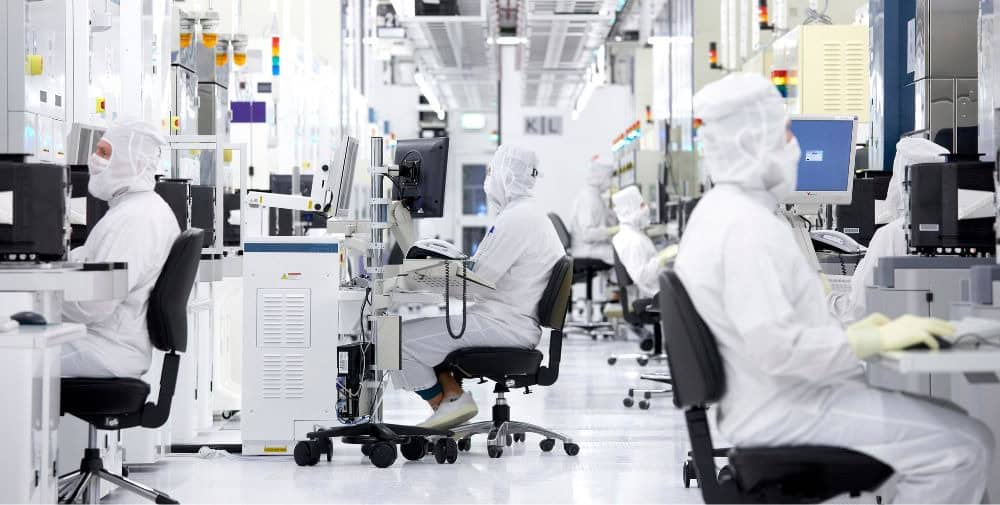The origin of smart systems
The roots of smart systems go back to the middle of the last century, when the first approaches to automating and networking devices and systems emerged. Three important technologies contributed to the development of smart systems in this context:
- Development of microelectronics as the basis of computer technology
- Development of microsystems technology
- Development of modern communication technology
1. Development of microelectronics as the basis of computer technology
With the invention of the transistor (1947) and the realization of the first semiconductor integrated circuits in 1958, as well as the development of microprocessors in the 1970s, a dramatic development of all electronics has been initiated. Since then, electronics has almost completely changed to semiconductor electronics. Microelectronic circuits are distinguished from conventional electronic circuits by two main features: integration and miniaturization. This is the basis not only for computer technology but also for smart systems to process, store and access data.
2. Development of microsystems technology
Semiconductor materials and microelectronic manufacturing processes are also applied to non-electrical components. After a silicon wafer with integrated piezoresistors was used as a mechanical deformation body for the first time in 1962, countless new miniaturized functional and shaped elements, components and manufacturing processes for micromechanics, microfluidics and microoptics have been developed to date. The main focus of development is on miniaturized sensors and actuators. All these microsystems have typical structure sizes in the micrometer and nanometer range and consist of several components. The overall function is only fulfilled by the interaction of the individual components as a complex miniaturized unit. Consequently, microsystems are an essential foundation of smart systems.
3. Development of modern communication technology
While the first smart systems exclusively transmitted their signals from one component to another by wire, decentralized data analysis has become standard with the dramatic advancement of wireless communication. Today, modern communication standards allow both energy-efficient transmission at close range – via Bluetooth LE, for example – and the highest data rates with low latency via the 5G mobile network. Smart systems today are thus almost always able to use a cloud infrastructure and access central data, storage space, computing capacity and applications. On the other hand, the increasing networking of smart systems and their components also enables the processing of time-critical data in particular to be carried out closer to the sensor again and still benefit from the advantages of cloud computing. The optimal trade-off between centralized (“cloud computing”) and decentralized (“edge computing”) data processing while ensuring more secure, reliable and cost-efficient communication is a key challenge in Internet of Things applications today.
The first smart system
The truly first smart system cannot be pinned down to a single point, as its development was gradual and spanned different areas. However, there were important milestones and predecessors of today’s smart systems:
The concept of the “Homes of the Future” was already introduced in the 1950s. Automated home technology such as automatic door openers, programmable thermostats and remote-controlled lighting can be seen here as the first forms of smart systems.
In the 1980s, the concept of “smart homes” was further developed. For example, the company X10 developed a technology for wireless control of household appliances and lighting via the power grid.
In general, smart systems are currently divided into three generations. While the first generation of the 1980s,1990s is mainly characterized by the fact that they consist of a certain number of individually packaged components / devices which are connected, for example, on a printed circuit board. They are still used in medical applications such as hearing aids and pacemakers, and in automotive applications such as airbag systems or electronic stabilization systems.
Smart systems of the second generation are already multifunctional sensor and actuator systems. They go beyond simple signal processing and become predictive and reactive systems equipped with self-test functions. Therefore, they are able to adapt to critical environments. They already operate partially autonomously.
The introduction of the “Internet of Things” (IoT) in the 1990s was an important milestone in this regard. IoT is the basis for devices being connected to each other via the Internet and exchanging data. This, in turn, enabled the development of smart devices that can communicate with each other.
With the advent of the Internet in the 1990s and the rapid development of sensors, data analytics and artificial intelligence, smart systems gained momentum. The ability to connect devices and systems and analyze data in real time opened up entirely new horizons for innovation and efficiency gains.
Since then, the development of smart systems has accelerated, primarily due to increasingly rapid data analysis and modern sensor technology. The integration of artificial intelligence (AI) into smart systems, and meanwhile the individual components of these systems, now promises to exponentially accelerate progress to date. This is the basis for third-generation smart systems. These are able to take over complex human perception and cognition functions, build self-organizing networks and operate completely self-sufficiently in terms of energy. Therefore, they will act independently and do not necessarily require human control or decision-making. These are therefore autonomous systems that will be the key element in linking the physical world with the virtual world.
Today, we already find such smart systems in areas such as home automation, healthcare, logistics and Industry 4.0.
The semiconductor industry as a smart pioneer in production
Semiconductor manufacturing is a particularly impressive example of the use of smart systems in the production environment. The characteristics of the microelectronics industry include continuous but often cyclical growth with high volatility and production with a strong division of labor at many locations distributed around the world. The pressure to innovate and cut costs is correspondingly high at the European and especially the German sites (such as Saxony), which they counter with a high level of automation. For example, the Dresden semiconductor fabs of Infineon and GlobalFoundries are not only among the largest fabs in the world, but also among those with the highest degree of automation (up to 100 percent).
In the meantime, the use of smart systems and artificial intelligence for predictive maintenance of production facilities, monitoring product quality or automating logistics processes is standard practice here. Many of these innovations are being jointly developed in cooperation with the high-tech companies in Saxony. The semiconductor industry and the Silicon Saxony region in particular are thus an important driver and technological pioneer for the entire electronic value chain.
Smart systems developed and researched in Silicon Saxony
Smart systems consist of various components and modules, include hardware and software. The communication of the individual components with each other and with the environment is integrated. Interdisciplinary collaboration is the key to successful developments.
Core components of a smart system are sensors and actuators. Especially in this area, companies in Silicon Saxony are also pioneers. Companies such as Robert Bosch, Infineon Technologies, ST Microelectronics, NXP, ams OSRAM, Bosch Sensortec or X-FAB are leading manufacturers of components and systems in the field – and all active in Silicon Saxony. In addition, SMEs are active in the development and production of smart systems. In some cases, they work with their own designs of sensors and actuators, which are manufactured at X-FAB, for example.
In the area of software as an indispensable enabler, important players can now also be found at the location. The cooperation between large software companies such as SAP or Telekom MMS and innovative start-ups, small and medium-sized enterprises (SMEs) is becoming increasingly important in this regard.
Both areas – i.e. hardware and software – are supported in their ecosystems by excellent research institutions for basic and applied research, such as the Forschungsfabrik Mikroelektronik, as well as the University of Excellence TU Dresden and many other universities in the region. Cooperation with international research centers such as the CEA-LETI, IMEC, VTT, and others also contributes to this.
Not to be forgotten are the contributions of Saxon companies and research institutions in the field of communications and network technology. For example, the TU Dresden as well as companies such as 5G Lab, CampusGenius, LoRaTo, UIT, ZIGPOS and many others are considered pioneers here.
Outlook into the future of smart systems
The future of smart systems is promising. As artificial intelligence, machine learning and advanced robotics continue to advance, smart systems will become even smarter, more adaptable and more autonomous. The future will bring seamless integration of smart technologies into our daily lives to further enhance efficiency, convenience and safety.
Conclusion
Smart systems have had a remarkable journey and are now at a point where they can fundamentally change the way we live, work and interact. As technology continues to evolve and innovative solutions are introduced, there is no doubt that we are in for an exciting future in which smart systems will play an even greater role. Being able to actively shape this development is a particularly important and exciting task for our network. Fundamental aspects, such as (data) security, security of the systems, conservation of resources, CO2 neutrality and sustainability in all its facets here also to think, more than just a duty in this overall process.
_ _ _ _
Authors

Dr. Martina Vogel
Head of Working Group Smart Systems & IoT, Fraunhofer ENAS
👉 LinkedIn
👉 Fraunhofer Institute for Electronic Nano Systems

Christoph Kögler
Head of Working Group Smart Systems & IoT, Infineon Technologies Dresden
👉 LinkedIn
👉 Infineon Technologies Dresden





